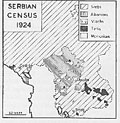 Map of G. Lejean, French (1861). Map of G. Lejean, French (1861).
Lejean was sent in a journey to the Ottoman Empire to gather information for the French government. His observances of the ethnic composition of the areas he visited produced this map. |  Map of G. M. Mackenzie and A.P. Irby, British (1867). Map of G. M. Mackenzie and A.P. Irby, British (1867).
The two ladies, Mackenzie and Irby, traveled through the Balkans to show the essentially Slavic nature of the peninsula. They did mark what they concluded to be Albanian inhabited lands. |
 Map of H. Kiepert, German (1876). Map of H. Kiepert, German (1876).
Kiepert was a professor at the University of Berlin. He had knowledge of Balkan history. He also inquired official sources in Istanbul and was influenced by the Greek historian P. Aravantinos (1856-7). |

Map of K. Sax, Austrian (1878).
Karl Sax was a consul of the Austria-Hungary Empire at Adrianople. He was well acquainted with Balkan affairs and had cultivated an intellectual interest in cartography. He made use of previous maps and official reports of populations by Austrian and Bulgarian offices. |
 Map of E. Barbarich, Italian (1905). Map of E. Barbarich, Italian (1905).
The Italian E. Barbarich published a book about the Albanians which contained an interesting map. He interpreted Albania in a very liberal manner to include the whole of Epirus, western Macedonia, the whole of the Drin valley and Kosova. |  Map of J. Cvijic, Serbian (1909). Map of J. Cvijic, Serbian (1909).
A map showing the pro-Serb view and a reflection of Serbian policy of the time. As far as Albania is concerned, Cvijic asserted that the northern region was inhabited by albanianized Serbs and most of the south by albanianized Greeks. |
 Map of the Albanian colony in Istanbul (1920). Map of the Albanian colony in Istanbul (1920).
This was the first map produced by Albanians, namely, it was produced by a colony of wealthy Albanians living in Istanbul. This map was the basis of Albanian government of the time proposition of Albania's boundaries. |  Serbian Census of 1921. Serbian Census of 1921.
This map was produced by the Serbian government as a result of the 1921 census of the Yugoslav kingdom. To distinguish nationalities it used the 'mother-language' criteria. It clearly shows Kosova to be predominantely Albanian-speaking. |
 Map by the German Foreign Office (1940). Map by the German Foreign Office (1940).
This highly detailed map was produced by the Geographical Division of the German Foreign Office and it was based on local official information. |  British P.C.G.N. (1942). British P.C.G.N. (1942).
The Permanent Committee on Geographical Names for British Official Use produced this map in 1942. The method used was a simple shading of linguistic zones. |
 Map of K. Sax, Austrian (1878).
Map of K. Sax, Austrian (1878).








No comments:
Post a Comment